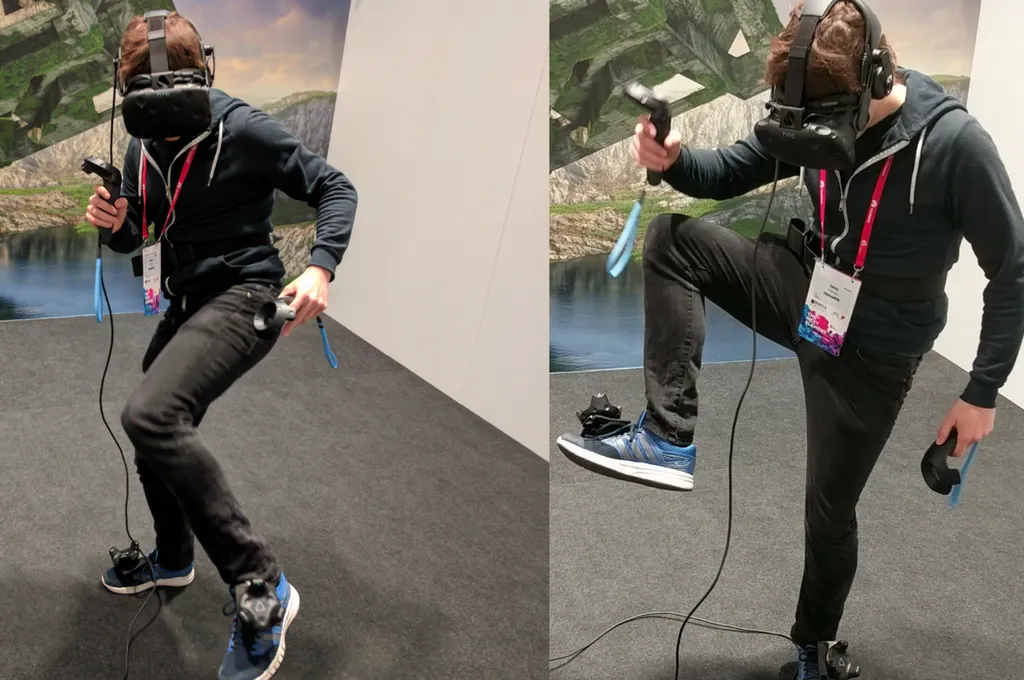The scale for awesome things you can do in VR keeps increasing. First, I could see a dinosaur as if it were really there as it walked towards me, perhaps sniffing right in front of me as he pondered a potential meal. Then I could punch dinosaurs with position-tracked controls, realistically defending myself should they choose to attack. Now? I can kick dinosaurs. In the face. And it’s awesome.
A month ago we saw developer Cloudgate Studio experiment with full-body tracking on the HTC Vive, using two controllers for hands and another two strapped to your feet. The result was a surprisingly accurate approximation of your full body inside VR. At the time the developer noted that it would implement the Vive’s new Tracker peripheral, switching out the controllers on the feet, as soon as it possible. Well, now it’s done that and it looks something like this.
A build of Cloudgate’s Island 359 was on display at this year’s Mobile World Congress using these two makeshift add-ons, which hooked under the laces in my shoes. A belt with another tracker tied around it went around my waist, something the developers said it would implement in last month’s video for a touch more accuracy.
As the game booted up I was instructed to stand with my feet in some green outlines, with a mirror in front of me. Once I was alligned I saw the floating hands and feet transform into a full avatar in seconds, with no other calibration needed. The first time I did this I ended up with strange, elongated gorilla arms (I don’t think I was holding my hands in the right place), but the second time it worked much better. I could look down and see my body, and my arms would follow my hands — for the most part — in a realistic fashion.
There were the expected occasional glitches, with arms getting out of sync, but Cloudgate has only had the Trackers for a few weeks and with a consumer roll out of Vive Trackers not happening until later this year it’s got plenty of time to iron it out even more.
Actually playing Island 359 with this tracking was a lot of fun. In last month’s video we saw the developer kick items over. Here, I was lashing out at dinosaurs with my feet and sending them flying. Smaller dinosaurs would run up to me, and I’d stomp down on them, killing them instantly (yes, there was a guilty pleasure to it). For larger dinosaurs I’d sweep my leg into them. The tracking might have been a little glitchy, but it didn’t fail me.
As I continued to play I got a little more confident with what the tracking could do. I was attacked from behind and instead of turning around to deal with the problem I simply kicked my leg backwards, then turned to find an enemy crumbled on the floor. It made the game’s action more versatile and liberating than it already was.
The key to this small breakthrough is giving players options. At $99.99, not every Vive owner is going to buy a tracker, let alone three or more of them. But Cloudgate’s work isn’t essential to the Island 359 experience, it’s additive. It’s already playable with just your two regular Vive controllers, this just makes it that bit more immersive.
But sharing this work and letting other developers implement it into their own games could create a scalable VR experience that doesn’t fragment the user-base because it does’t leave anyone out.
We’re still some months from finding out just how big of an impact this use of Vive’s Trackers will be, but I’m willing to bet a lot of enthusiasts will be ordering at least three units when it finally starts to roll out.






























